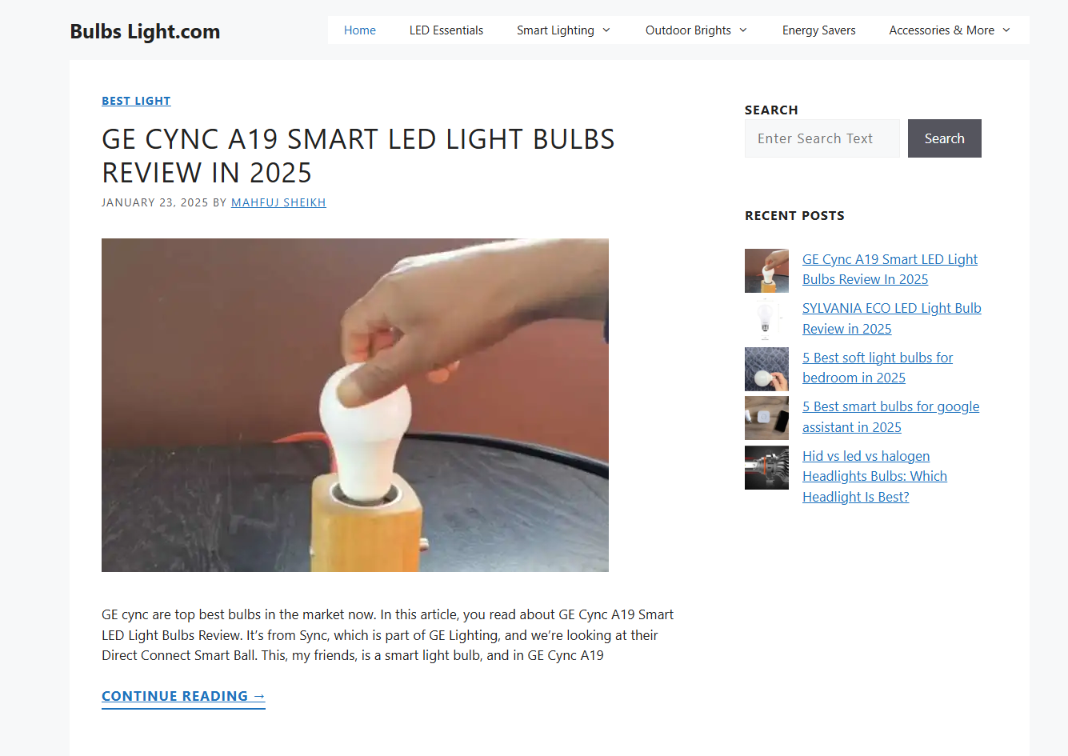
Best Bulbs for Outdoor Lights: A Comprehensive Guide
Choosing the right bulbs for your outdoor lighting can make a significant difference in both functionality and aesthetics. Outdoor lighting serves multiple purposes, from illuminating pathways and enhancing security to creating a warm and inviting ambiance for your outdoor spaces. However, not all bulbs are created equal. In this guide, we’ll walk you through the best bulbs for outdoor lights, considering factors like brightness, energy efficiency, durability, and design.
Factors to Consider When Choosing Best Bulbs for Outdoor Light:
Before diving into the best bulb options, it’s important to understand the key factors you should consider:
1. Weather Resistance
Outdoor bulbs must be able to withstand harsh weather conditions, including rain, snow, heat, and humidity. Look for bulbs labeled as "weather-resistant" or "suitable for outdoor use."
2. Brightness and Wattage
The brightness of a bulb is measured in lumens, while wattage indicates energy consumption. For outdoor lights, choose bulbs that provide sufficient illumination without consuming excessive energy. For instance, 800-1,200 lumens is ideal for security lighting, while 200-600 lumens may suffice for decorative or pathway lighting.
3. Color Temperature
Measured in Kelvins (K), color temperature determines the warmth or coolness of the light. Warm white (2,700K-3,000K) creates a cozy atmosphere, while cool white (4,000K-5,000K) is better for task lighting and security.
4. Energy Efficiency
Energy-efficient bulbs, such as LEDs, consume less power and last longer, saving you money in the long run. Look for Energy Star-certified options for guaranteed efficiency.
5. Durability and Lifespan
Since outdoor bulbs are exposed to the elements, durability is crucial. LED bulbs, for example, can last up to 25,000 hours, making them a cost-effective choice.
6. Type of Outdoor Light Fixture
Consider the type of fixture you’re using, whether it’s a floodlight, wall-mounted sconce, string light, or pathway light. Some fixtures may require specific bulb shapes or bases.
Types of Best Bulbs for Outdoor Lights
1. LED Bulbs
Why Choose LEDs?
LEDs (Light Emitting Diodes) are the most popular choice for outdoor lighting due to their energy efficiency, durability, and versatility. They consume up to 80% less energy than incandescent bulbs and have a significantly longer lifespan.
Best Use Cases:
- Security lighting
- Floodlights
- Pathway and garden lighting
- String lights for patios
Pros:
- Extremely energy-efficient
- Long lifespan (15,000-25,000 hours)
- Available in various color temperatures
- Resistant to extreme temperatures
- Environmentally friendly (contain no mercury)
Cons:
- Higher upfront cost compared to other bulbs
2. Halogen Bulbs
Why Choose Halogen?
Halogen bulbs are a type of incandescent bulb that provides bright, white light. They are ideal for task lighting or areas where high visibility is needed.
Best Use Cases:
- Security lights
- Spotlighting architectural features or landscaping
Pros:
- Brighter than standard incandescent bulbs
- Good color rendering
- Dimmable options available
Cons:
- Shorter lifespan (1,000-2,000 hours)
- Less energy-efficient than LEDs
- Can get very hot during operation
3. Compact Fluorescent Lamps (CFLs)
Why Choose CFLs?
CFLs are an energy-efficient alternative to incandescent bulbs. They are more affordable than LEDs and offer decent energy savings.
Best Use Cases:
- Porch lights
- General ambient lighting
Pros:
- More energy-efficient than traditional incandescent bulbs
- Available in various shapes and sizes
- Affordable upfront cost
Cons:
- Contain small amounts of mercury, requiring careful disposal
- Limited durability in extreme weather conditions
4. Incandescent Bulbs
Why Choose Incandescents?
Although they’re becoming less common due to energy inefficiency, incandescent bulbs are still favored for their warm light and affordability.
Best Use Cases:
- Decorative fixtures
- String lights
Pros:
- Warm, inviting light
- Affordable upfront cost
Cons:
- Short lifespan (750-1,200 hours)
- High energy consumption
- Not weather-resistant
5. Solar-Powered Bulbs
Why Choose Solar Bulbs?
Solar-powered bulbs are a sustainable choice for outdoor lighting. They charge during the day and automatically light up at night, requiring no wiring or external power source.
Best Use Cases:
- Pathway lights
- Garden accents
- Decorative lighting
Pros:
- No electricity required
- Environmentally friendly
- Easy to install
Cons:
- Dependent on sunlight for charging
- May not provide consistent brightness
6. Smart Bulbs
Why Choose Smart Bulbs?
Smart bulbs allow you to control your outdoor lighting via apps or voice commands. Many options also offer features like color-changing capabilities and scheduling.
Best Use Cases:
- Decorative and ambiance lighting
- Smart home integration
Pros:
- Remote control and automation
- Customizable settings
- Energy-efficient (usually LED-based)
Cons:
- Higher upfront cost
- Requires a stable Wi-Fi connection or smart hub
Maintenance Tips for Outdoor Bulbs
- Clean Fixtures Regularly: Dirt and debris can reduce brightness. Clean your fixtures every few months.
- Check for Damage: Inspect bulbs and fixtures for signs of wear or water damage.
- Replace Bulbs as Needed: Don’t wait for bulbs to burn out completely. Replace them when they start dimming.
- Use Timers or Sensors: Timers and motion sensors can prolong bulb life by ensuring lights are only on when needed.
- Store Spares: Keep extra bulbs on hand, especially during colder months when replacements may be harder to find.
Post a comment